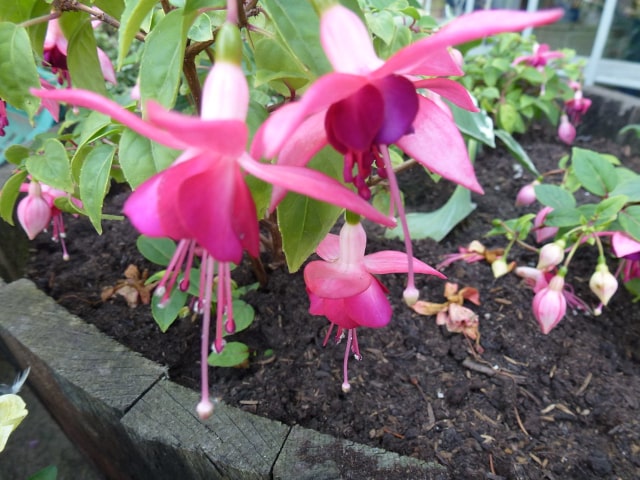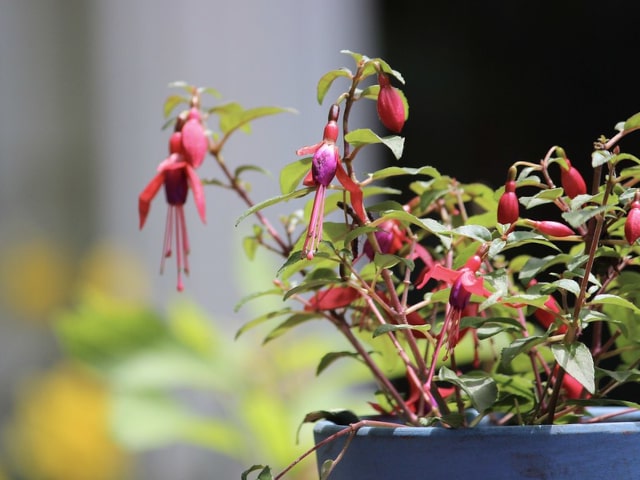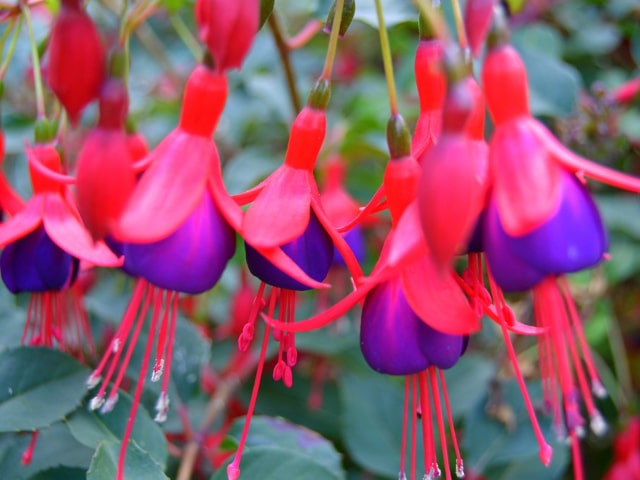
Fuchsias are extremely popular house plants that many people like to grow in their homes. However, it is also possible to grow them outside: on your patio, the balcony or even in your own garden.
Many people choose to grow Fuchsias specifically for their wonderful, two-coloured flowers. These flowers are bell-shaped and look like little hanging skirts that have come from a plant. Is is a great thing that these lovely flowers will last through the whole summer, so they will make your garden look wonderful for all the warm months. This is why many people choose to grow Fuchsias outside instead of indoors.
However, if you choose to grow Fuchsias outdoors, it is important to know went to plant them, and what kind of care thy require in your garden. Also, keep in mind that there are Fuchsia varieties that need to be brough indoors during the cold months.
Plant Fuchsias Outside: Different Varieties
The first thing you need to know is that Fuchsias come in hardy and tender, also known as half-hardy, varieties. Hardy varieties can easily survive winter outside and they are typically grown in some sort of a permanent spot in the garden. They are often grown as a specific shrub in your garden or as a hedge. These varieties typically flower from May to September. However, if you live in a warm area, you may have them grown throughout the whole year.
On the other hand, there are also tender varieties, also known as half-hardy varieties of Fuchsias. They are more sensitive to cold. You can still grow these varieties outside, and you can plant these Fuchsias in your garden, but you need to plant them in the pot and then bring them inside during the cold weather. These varieties of Fuchsias can be easily killed by frost, which is something that you definitely want to avoid. Alternatively, you may treat these as annual plants and simply discard them at the end of the growing season. However, if you wish to keep them for the next year, you need to bring them inside for the winter. These types of Fuchsias make a great addition to any patio or a garden as a potted plant.
How to Plant Fuchsias Outside
It is not difficult to grow Fuchsias outside. What you need to remember is that they require sun or some partial shade. It means that you should never plant them in a spot that sees a lot of direct sun, particularly in the summer. Instead, it is best to choose a place that is sheltered at least partially, so they're not scorched by the heat.
When it comes to soil requirements, Fuchsias are not really demanding. You can grow them in basically any type of soil. You just need to make sure that it well-drained.
Plant Fuchsias Outside: Hardy varieties
Keep in mind that Fuchsias, particularly those of the hardy varieties, are very sensitive for moving, so make sure that you choose the best spot for them in the garden. It is important that the spot is good for your plants, so you don't move them later.
You should plant Fuchsias that are hardy in the spring or in the early summer. It is best to plant hardy Fuchsias only when the danger of frost has passed. You should also acclimatize them a few weeks before you plant them in the garden.
Fuchsias are very easy to plant. All you need to do is to dig in a lot of organic matter into the soil before you plant your Fuchsias in the garden. This will ensure that they are getting all of the nutrients that they need.
After you plant Fuchsias in their permanent spot, make sure to water well and thoroughly. It is also a good idea to add a layer of mulch. You can use garden compost for this purpose: it is also great for preserving moisture. Mulch will also help feed your Fuchsias.
Make sure to water properly until the plants are well-established. Once that Fuchsias are planted and established in your garden soil, you will probably not need to water them a lot, unless there is drought in your area. If this happens, make sure to give them a good and thorough watering.
In the spring, you should mulch Fuchsias with some gardening compost. This will improve moisture around the plant. You can also add some feed to your plants, such as fish, bone, or blood meal. Just make sure to put it around the base of the plant
Remember, you can keep hardy Fuchsias in the garden through the winter. However, keep in mind that they might need some protection during the coldest months. Make sure to give them a thick layer of mulch during the fall, which will protect their roots. Also, if it gets too cold in the winter, cover them with fleece to protect them.
Plants Fuchsias Outside in Pots
A great thing about Fuchsias is that they can be easily grown in pots, indoors or outdoors in your garden or patio. For example, many Fuchsias that are trailing plants are great for hanging baskets or containers. You can also train them as standards. All you need to do is to make some preparation in the spring by removing their lower side shoots. Also make sure to support the plants with some sort of a cane or a stick.
You can also grow Fuchsias as standards in pots, which is a good solution for tender Fuchsia varieties, since they need to be protected from cold weather. Keep in mind that these fare much better without underplanting because they fill out their container in no time.
It is it is important for Fuchsias that are planted in containers to receive some compost. This will make them healthier and stronger. You can use compass that is peat-free. You may also wish to add some slow-release fertilizer, and make sure to water your plants properly. Fuchsias that are in containers need to be watered regularly. This will keep the compost moist without ever becoming soggy. Also, always make sure to drain away any excess water.
Fuchsias in the pots need to be fed regularly with liquid plant food. For example, you may use tomato food. Make sure to do this through the whole summer because it encourages blooming.
Tender Fuchsias that are grown in pots outdoors need to be brought inside during the cold months. They simply cannot survive winter outside. You should bring them inside during the fall and place them in a frost-free but not too warm area. A porch or a cool greenhouse is a good choice for this purpose. When bringing Fuchsias indoors, you should remove any damaged leaves. You may also want to cut them back by around half. Doing this will keep them compact. During the winter they will become dormant at some point and they will drop all of their leaves. At this point, you should put Fuchsias in a garage or a shed that is free from frost.
Photo credit: Mara 1




0 Comments